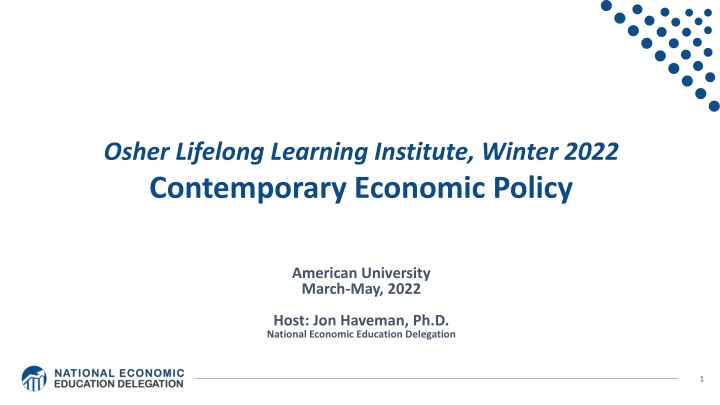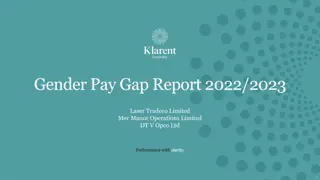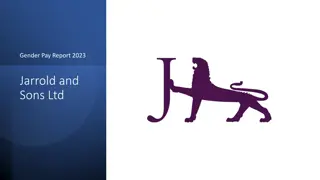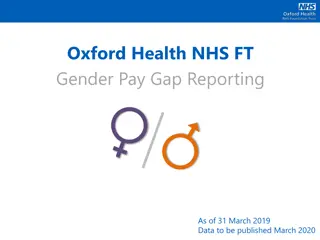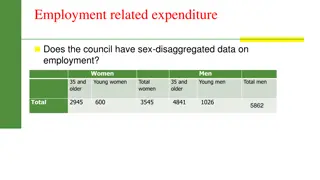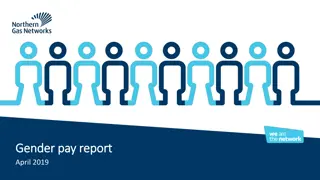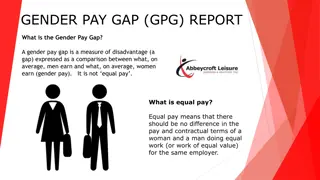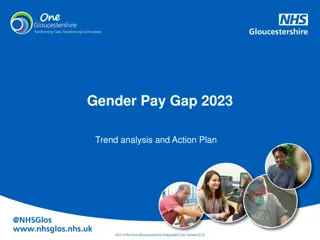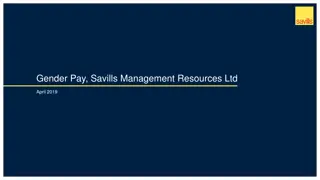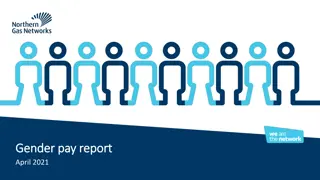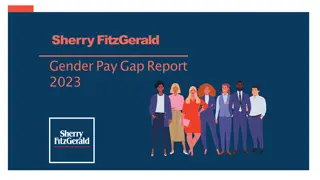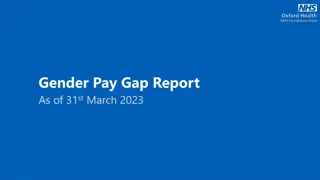Contemporary Economic Policy - Gender Pay Gap Analysis
Explore the gender pay gap issue impacting the workforce, with insights on causes, solutions, and statistics. Discover the significance of pay equity for women and the challenges faced in achieving equality.
Download Presentation

Please find below an Image/Link to download the presentation.
The content on the website is provided AS IS for your information and personal use only. It may not be sold, licensed, or shared on other websites without obtaining consent from the author.If you encounter any issues during the download, it is possible that the publisher has removed the file from their server.
You are allowed to download the files provided on this website for personal or commercial use, subject to the condition that they are used lawfully. All files are the property of their respective owners.
The content on the website is provided AS IS for your information and personal use only. It may not be sold, licensed, or shared on other websites without obtaining consent from the author.
E N D
Presentation Transcript
Osher Lifelong Learning Institute, Winter 2022 Contemporary Economic Policy American University March-May, 2022 Host: Jon Haveman, Ph.D. National Economic Education Delegation 1
Available NEED Topics Include: Coronavirus Economics Immigration Economics US Economy Housing Policy Climate Change Federal Budgets Economic Inequality Federal Debt Economic Mobility Black-White Wealth Gap Trade and Globalization Autonomous Vehicles Minimum Wages US Social Policy 2
Course Outline Contemporary Economic Policy - Week 1 (3/11): US Economy & Coronavirus Economics - Week 2 (3/18): Federal Debt (Brian Peterson, Central College) - Week 3 (3/25): Trade and Globalization (Alan Deardorff, Univ. of Michigan) - Week 4 (4/1): Healthcare Economics (Veronika Dolar, SUNY-Old Westbury) - Week 5 (4/8): Economics of Immigration (Jennifer Alix-Garcia, Oregon St. Univ.) - Week 6 (4/15): Economic Inequality (Kyle Montanio, Colorado University - Denver) - Week 7 (4/22): Economic Mobility (Kathryn Wilson, Kent State University) - Week 8 (4/29): Discrimination in US Policy History (Jon Haveman, NEED) - Week 9 (5/6): The Black-White Wealth Gap (Mike Shor, Univ. of Connecticut) - Week 10 (5/13): The Gender Pay Gap (Mallika Pung, Univ. of New Mexico) 3
The concept of gender pay gap. A miniature man and a miniature woman sitting on top of a pile of coins at different heights in front of a bar graph. The concept of gender pay gap. A miniature man and a miniature woman sitting on top of a pile of coins at different heights in front of a bar graph. gender pay gap stock pictures, royalty-free photos images Gender Pay Gap Symbol for gender equality. Hand turns a dice and changes a unequal sign to a equal sign between symbols of men and women. Symbol for gender equality. Hand turns a dice and changes a unequal sign to a equal sign between symbols of men and women. gender pay gap stock pictures, royalty-free photos images Mallika Pung, Ph.D. University of New Mexico May 13, 2022 4
Outline What is gender wage gap? Gender wage gap in numbers. What are the potential causes for this gender wage gap? What can we do?
The Issue of Gender Wage Gap We have to pass pay equity for women workers. It is not acceptable that women are making 78 cents an hour compared to men. -- Sen. Bernie Sanders (I-Vt.), speech to the National Press Club, March 9, 2015 ..42% [women] in the United States say they have faced discrimination on the job because of their gender One of the biggest gender gaps is in the area of income: 25% [women] say they have earned less than a man who was doing the same job.. -- 2017 Pew Research Center survey 6
Popular Theories Occupational segregation Biased managers and co-workers Inferior bargaining skills Lack of competitiveness And more We will delve deeper into what is meant by gender wage gap and how economists think about the issue. 7
Significant strides have been made Progress made in combating gender inequality and discrimination against women in workplace since the 1970s - The Fair Labor Standards Act of 1938, - The Equal Pay Act of 1963, - Title VII of the Civil Rights Act of 1964, and - The Pregnancy Discrimination Act of 1973 in conjunction with - Affirmative Action and other movements aimed at diversity Gender Revolution 8
What is Gender Wage Gap? Gender wage gap represents the difference in average earnings of women relative to those of men. The gap is usually calculated as a ratio of women s earnings to men s earnings. - For example, in July 2021, median weekly earning for full-time women workers was $914, and that for men was $1105. - Therefore, the gender wage gap in July 2021 was: $914 $1105= 82.7% 10
Gender Wage Gap Over the Years Gap between men and women s median earnings has narrowed considerably since the late 1970s. 11
Wage Gap Across the Globe Average OECD United States 13
What is NOT included in these calculations? These are unconditional or uncontrolled or raw wage gap. The difference doesn t take into account important determinants of earnings such as: - Age - Occupation - Educational attainment - Job skills and responsibilities - Work experience - Specialization Gender wage gap is not a single statistic; it s dynamic. 14
Wage Gap by Age The gap between men and women s median earnings was the largest among those aged 45 years or older. 15
Wage Gap by Race/Ethnicity Earnings between women and men were largest among Asians and among Whites. differences Asian women earned 79% as much as Asian men, and White women 82%as much as White men. earned Black women had median earnings that were 92% of Black men s, and Hispanic women s earnings were 89% of Hispanic men. 16
Wage Gap by Level of Education College pays among all workers, median earnings of those with at most a HS degree were 55% of those with at least a bachelor s degree. The gap between men and women s median earnings was the largest among college graduates, with women s median earning at only 75% of men s. 17
Wage Change by Level of Education Long-term trend in inflation-adjusted earnings has been more favorable for women than for men. 18
Wage Gap Widens with Age and with Years Since Leaving School From Bertrand, Goldin, Katz (2010) Directly following MBA receipt, average earnings are comparable among men and women, but they soon diverge. In the first 9 years after graduation, women s average earnings increase by 117%, while those of men increase by 208%. 20
Wage Gap Among MBA Graduates Not Random The sample controls for ability, training and education Almost all the gap can be explained by: - Career interruptions - Differences in average weekly work hours o 49 hrs vs 57 hrs for men o More part-time, self-employed workers The gap grows largely with the arrival of children - Well-intentioned paternalism by supervisors - Husband s position on the earnings distribution and its interaction with children also a factor Several studies, even those from Nordic countries, support these results 21
Occupations with the Highest Wage Gap, 2021 Occupation Female-Male Median Weekly Earnings Ratio 56% 60% 65% 66% 67% 68% 70% 70% 70% 72% 72% 72% 73% 73% 73% 73% 74% 74% Share of Women in the Occupation 33% 51% 40% 19% 54% 89% 19% 30% 30% 39% 51% 22% 56% 38% 60% 58% 46% 40% Share of Women Workforce Securities, commodities, and financial services sales agents Medical scientists Personal financial advisors Other engineering technologists and technicians, except drafters Insurance sales agents Medical assistants First-line supervisors of production and operating workers Chief executives Sales managers Bus drivers, transit and intercity Credit counselors and loan officers Supervisors of transportation and material moving workers Financial managers Inspectors, testers, sorters, samplers, and weighers Market research analysts and marketing specialists Claims adjusters, appraisers, examiners, and investigators First-line supervisors of retail sales workers Retail salespersons Total 0.1% 0.1% 0.3% 0.1% 0.5% 0.8% 0.3% 0.7% 0.3% 0.1% 0.4% 0.1% 1.3% 0.6% 0.4% 0.4% 1.9% 1.3% 9.8% 25
These are still unadjusted wage gap numbers In the previous slides we controlled for one factor at a time that might affect earnings of workers. However, controlling for just one of the factors may not fully explain earnings differences. For example, when comparing median earnings differences by occupation, we still would like to know if these differences can be further explained by differences in other key factors such as - age, - job responsibilities, - work experience, and - other individual life choices such as marital status or to have children and to take time off to raise them. 26
Explaining Gender Wage Gap by Occupation Women, traditionally, the on-call parent Goldin [2021] Prefer occupations with - shorter hours, - fewer on-call hours, - predictable schedules - standardized products/services o greater substitutability of workers within teams Men, traditionally, opt for jobs with greater time demands but pay more Appear to care less about time flexibility - Ready to work evening/weekend hours to meet clients 27
Explaining Gender Wage Gap by Occupation High time demand occupations: - Contact with others - Frequency of decision making - Time pressure - Structured vs. unstructured work - Establishing and maintaining interpersonal relationships Level of competition within an occupation Income inequality among men within an occupation 28
Earnings Penalty for Taking Time Out Occupations with the most wage gap tend to also be the highly skilled Earnings penalty for women (as well as men) for taking time out for career paths with the most prestigious degrees such as JD, MD, MBA or PhDs lawyers, physicians, managers or academicians is generally very high. Goldin and Katz (2008), Harvard and Beyond study: Earnings penalty for taking time off, at 15 years since leaving college with a Bachelors: - Lowest for MDs - Highest for MBAs at 1.4 times the penalty for MDs - Followed by JDs and PhDs at 1.2 times the penalty for MDs Women with children tend to do less well than men. 29
The Leaky Pipelines Phenomenon In occupations many professional - There s a more equitable gender distribution entry level, at - But at the higher ranks, number workers plummets. Time demands likely explanation? of female 30
Solutions to the gender wage gap issue Debiasing the labor market - Diversity training for supervisor and manager - Changing the organizational culture - Gender blind hiring/evaluation procedures Training women to be more competitive and removing unconscious bias Legislative actions by federal and state governments 31
The system not individual bias is the culprit The system is characterized by: - Decisions made by ordinary couples in terms of being on-call at work or at home - Cost of time flexibility at work The higher the cost of temporal flexibility, the higher is the likelihood of a couple to forego equity in favor of higher family income. Substitution among workers needs to be encouraged in occupations with high gender pay gaps 32
Private Sector is Responding... Slowly With more women entering the profession More men wanting equitable relationships with their life partners Costly job training Valuable client-employee relationships formed by the women in early years Firms have more incentive to retain the female employees now than ever. 33
Time Demand Tradeoffs and COVID-19 COVID-19 may have accelerated some of the trends towards more workplace flexibility. Remote work may have lasting beneficial impact on all workers, including women. But there may also be losses. - WFH = Working from Home or Working from Hell? Women s attachment to labor market at risk due to: - Difficulty in obtaining affordable, dependable childcare - Unpredictability in school closures/re-openings 34
What can we do? Reduce the cost of flexibility Increase or incentivize substitutability Reduce the cost of caregiving childcare as well as elderly care Alter societal norms We need men to lean out at work, support their male colleagues who are on parental leave, vote for public policies that subsidize childcare, and get their firms to change their greedy ways by letting them know that their families are worth even more than their jobs. Dreams won t come true aspirations won t be realized unless men are brought along for the rest of the journey -- Claudia Goldin 35
Thank you! Any Questions? www.NEEDelegation.org Mallika Pung, Ph.D. MallikaPung@gmail.com Contact NEED: info@NEEDelegation.org Submit a testimonial: www.NEEDelegation.org/testimonials.php Become a Friend of NEED: www.NEEDelegation.org/friend.php 36
